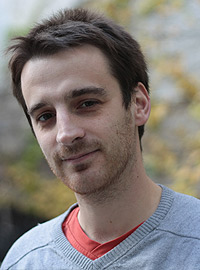Acoustic imaging with a small number of transducers using an acoustic cavity

Nicolas Etaix, Doctorant - PhD student Crédits : ESPCI ParisTechThis thesis deals with acoustic imaging using a small number of
transducers and a cavity. It has been shown in the laboratory that an imaging device could be obtained using only a few transducers. It is based on the use of a mixing chamber and the time reversal imaging technique.
A first experimental study was carried out with a duralumin plate of square geometry equipped with a single transducer. The whole system acts as a low profile acoustic antenna and allows the controlled focusing of an acoustic wave in the air.
Subsequently, we wanted to improve the focusing contrast of the
system. For this, the geometry of the cavity has been modified to
increase the number of modes. The focusing contrast depends on the
number of modes excited in the cavity. A plate of irregular geometry is first studied and used for ultrasound imaging experiments. Then, we have introduced an array of resonators. It is shown experimentally and numerically that this can greatly increase the modal density in a narrow frequency bandwidth and thus improve the contrast of focusing.
Then, a study based on the number of transducers is also performed and shows that the gain of the contrast with the number of transducers is limited due to the dependence of the modes excited.
Finally, during this thesis and since its beginning, the plates were characterized using a new technique for measuring local thickness studied in parallel. It is based on the measurement of vibrations of the plate on a circle and at its center. This technique is a great innovation and allows simple listening to the plate vibrations in order to deduce its thickness.
After his PhD, Nicolas Etaix will start his career in the industry and join the Dyson company, England, where he will integrate Research and Development teams







